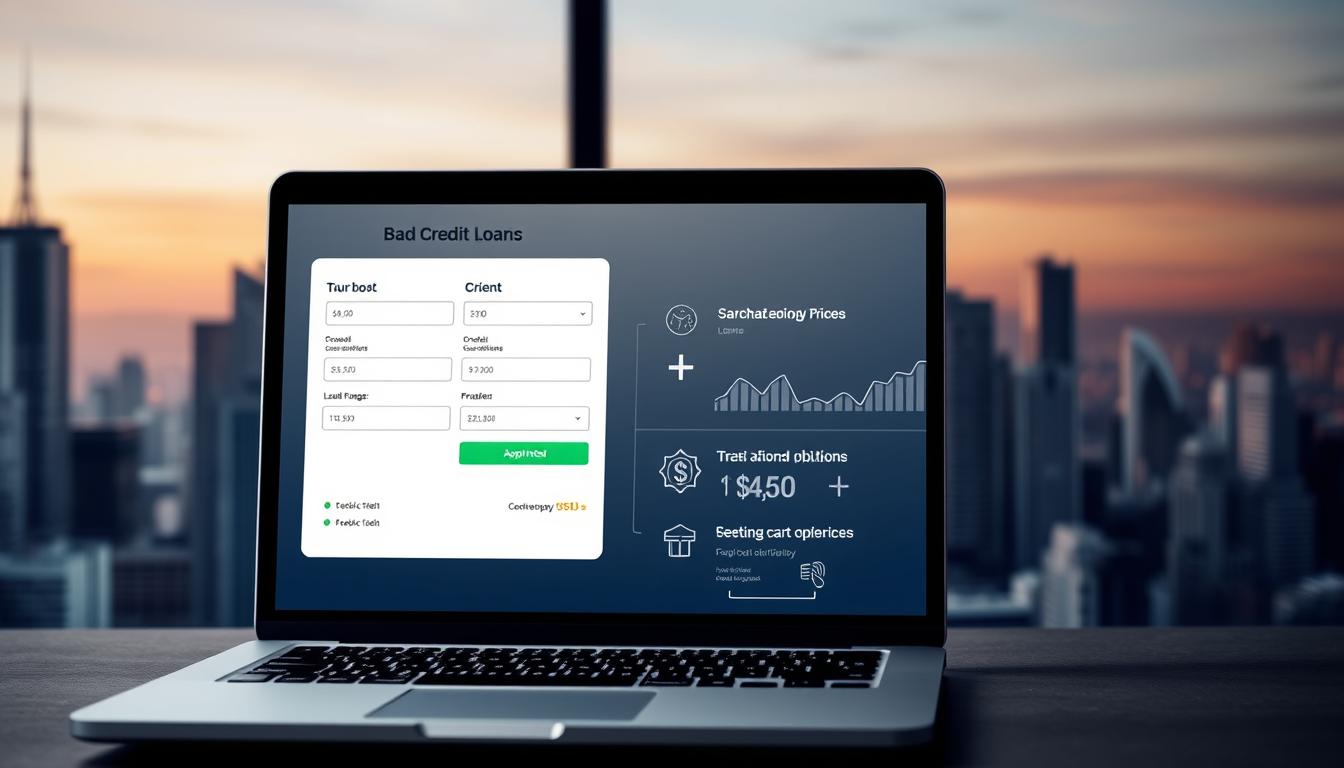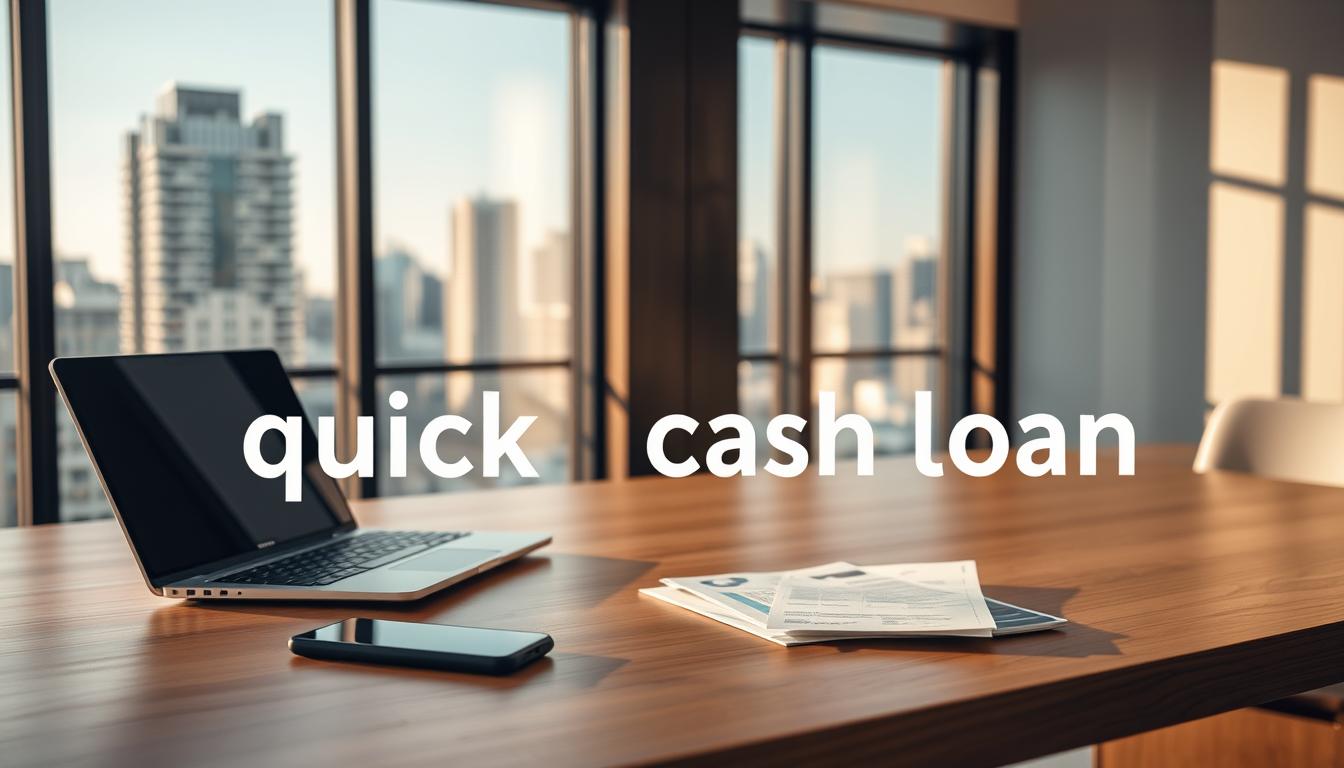Loans for Bad Credit: Get the Funding You Need
Millions of Americans struggle with bad credit, making it hard to get loans from regular lenders. We get how tough it is to deal with a low credit score. It really affects your financial health.
Getting a loan seems impossible when your credit isn’t good. But, there are loan options made for people in this situation.
We’ll look into these options. We want to help you find funding even with bad credit. Our aim is to make it simpler for you to get the financial help you need.
Key Takeaways
- Understanding the challenges of bad credit is crucial.
- Specialized loan options are available for individuals with bad credit.
- We will guide you through the process of obtaining necessary funding.
- Alternative lenders offer more flexible criteria than traditional lenders.
- Improving your credit score can enhance your loan eligibility.
Understanding Bad Credit and Its Impact
Bad credit is more than just a label. It shows a person’s or business’s credit history. This history indicates a higher risk for lenders.
A credit score below 580 is seen as bad credit. It’s based on payment history, credit use, and how long you’ve had credit. Lenders see people with these scores as higher risks. This can mean higher interest rates or even loan denials.
What is Considered Bad Credit?
A bad credit score is below 580. This number is not random. It’s based on how likely a borrower is to not pay back a loan.
Several things can lower your credit score. These include missed payments, high credit use, and negative marks like bankruptcies or foreclosures.
How Bad Credit Affects Loan Approval
Applying for a loan with bad credit means lenders see you as a risk. This can lead to higher interest rates or stricter terms.
In some cases, lenders might not approve your loan. They might see the risk of default as too high.
The Importance of Credit Scores
Credit scores are key in getting a loan. A good score can lead to better loan options. This includes lower interest rates and more favorable terms.
Keeping a good credit score is crucial. It’s vital for anyone, including those with bad credit, looking to improve their financial situation.
Types of Loans Available for Bad Credit
People with bad credit have many loan options. Each has its own benefits and downsides. Knowing these options helps you make smart choices that fit your money situation.
Personal Loans
Personal loans are flexible and can be used for many things. This includes paying off debt, covering unexpected costs, or buying big items. Bad credit lenders offer these loans with different rates and terms.
When looking at personal loans, check the lender’s needs, the loan’s rate, and how you’ll pay it back. Make sure it’s something you can handle financially.
Payday Loans
Payday loans give you quick cash, but they’re expensive. They have high interest rates and fees.
Before getting a payday loan, read the fine print. High costs can trap you in debt if not managed well.
Secured vs. Unsecured Loans
Loans are either secured or unsecured. Secured loans need collateral, like a car or house, for better rates but risk losing it if you can’t pay. Unsecured loans don’t need collateral but might have higher rates or stricter rules.
It’s important to know the differences when choosing a bad credit loan. This helps you pick the right one for your needs.
| Loan Type | Interest Rate | Collateral Requirement | Repayment Terms |
|---|---|---|---|
| Personal Loan | Variable | No | Flexible |
| Payday Loan | High | No | Short-term |
| Secured Loan | Lower | Yes | Variable |
| Unsecured Loan | Higher | No | Variable |
How to Improve Your Chances of Getting a Loan
Improving your loan chances with poor credit is possible. Lenders look at many factors when deciding. Knowing these can help you get ready and boost your odds.
Check Your Credit Report
Your credit report is key for lenders. It’s important to make sure it’s right and current. You can get a free report from Equifax, Experian, and TransUnion.
Look over your report for mistakes or old info. Fix any wrongs you find. This can raise your score. Also, watching your report helps you see what’s affecting your score.
Consider a Co-Signer
Having a good credit friend or family member co-sign can help. Their good credit can make you look better to lenders. But, remember, if you can’t pay back, they will.
This can hurt your relationship if not handled right. So, think it over carefully.
Improve Your Debt-to-Income Ratio
Your debt-to-income ratio matters a lot to lenders. It’s how much you owe versus how much you make. To better this, pay off debts and earn more.
| Debt Type | Monthly Payment | Strategies to Reduce |
|---|---|---|
| Credit Cards | $500 | Pay more than the minimum, consider balance transfer |
| Car Loan | $300 | Refinance for a lower interest rate |
| Mortgage | $1,200 | Consider a longer loan term to reduce monthly payments |
By using these tips, you can look better to lenders. This can help you get a poor credit loan or bad credit financing.
Finding Reputable Lenders
For those with bad credit, finding a trustworthy lender is key. The lending world has changed, offering more than just banks.
Online Lenders
Online lenders are now a good choice for bad credit. They offer quick applications and decisions. This makes them great for fast funding needs. Some focus on bad credit loan approval, with easier criteria than banks.
It’s important to check an online lender’s reputation and terms. Make sure they’re clear about fees and rates. For more info, check out CNBC’s guide to personal loans for bad credit.
Credit Unions
Credit unions are another option for bad credit. They’re owned by members and often have better terms and rates. They might look at more than just credit scores, helping those with bad credit.
Peer-to-Peer Lending Options
Peer-to-peer lending connects you directly with investors. This can mean better rates and terms. They might be more open to bad credit, but always check the details.
Here’s a quick comparison of these options:
| Lender Type | Credit Requirements | Interest Rates | Application Process |
|---|---|---|---|
| Online Lenders | Flexible, consider bad credit | Varying, potentially higher | Quick, online application |
| Credit Unions | More lenient, consider overall financial health | Generally lower | May require membership, personalized service |
| Peer-to-Peer Lending | Varied, can accommodate bad credit | Competitive, based on investor demand | Online platform, potentially faster |
Be careful and do your homework on lenders. This way, you can find the right one for your financial situation.
The Application Process Explained
Applying for a loan with bad credit needs careful planning. It’s key to know the steps and how to make your application stand out.
Documents You’ll Need
The first step is to gather all needed documents. You’ll likely need:
- Identification: A valid government-issued ID, like a driver’s license or passport.
- Proof of Income: Recent pay stubs, bank statements, or tax returns to show your income.
- Bank Statements: To see your current financial health and account management.
- Other Financial Documents: Depending on the lender, you might need more financial info.
What to Expect During Approval
After applying, the lender will check your credit and other factors. This includes:
- Credit Check: The lender will look at your credit history to judge your risk.
- Income Verification: They’ll check if you can pay back the loan.
- Debt-to-Income Ratio Assessment: To see if you can handle the loan payments.
Being ready for this can help your chances of getting approved.
Common Mistakes to Avoid
When applying for a loan with bad credit, avoid common mistakes. These include:
- Applying for Multiple Loans Simultaneously: This can hurt your credit score.
- Providing Inaccurate Information: Make sure all details are correct and honest.
- Not Reading the Terms: Understand the loan’s terms, like interest rates and repayment plans.
Avoiding these mistakes can improve your loan application success.
Terms and Conditions to Look For
It’s important to understand the terms and conditions of bad credit loans. This knowledge helps you make smart financial choices. When looking at bad credit loan options, pay close attention to what lenders offer.
One key thing to check is the interest rates on bad credit loans. These rates are often higher than regular loans. This can increase the total cost of the loan.
Interest Rates
Interest rates for bad credit loans can differ a lot between lenders. It’s important to compare rates from various bad credit lenders. This way, you can find the best deal.

Loan Amounts and Repayment Terms
Another important factor is the loan amount and how long you have to pay it back. Different lenders offer different amounts and repayment periods. This affects your monthly payments and how much financial stress it puts on you.
| Loan Amount | Repayment Term | Monthly Payment |
|---|---|---|
| $1,000 | 12 months | $88.85 |
| $2,000 | 24 months | $87.68 |
| $3,000 | 36 months | $91.44 |
Fees and Penalties
Also, be aware of any fees and penalties for late payments or early repayment. Reading these details carefully can help you avoid unexpected costs.
Some lenders might charge origination fees, late payment fees, or penalties for early repayment. Knowing about these fees is key to managing your loan well.
Alternatives to Traditional Loans
For those with bad credit, traditional loans might not be the only choice. It’s important to look at other options when facing financial troubles. These alternatives can offer relief or support.
Credit Counseling Services
Credit counseling services can be a big help for those with debt. They guide on managing debt, budgeting, and improving credit scores. Working with a credit counselor can help you become debt-free and improve your financial health.
We recommend finding reputable credit counseling agencies. They offer personalized advice and support.
Government Assistance Programs
Government programs are there to help during tough financial times. They vary by state and can cover housing, utilities, and more. For those with bad credit, these programs can ease financial burdens.
Looking into the specific programs in our area is a good idea.
Emergency Funds and Grants
Emergency funds and grants can provide quick financial help. Some groups offer grants that don’t need to be repaid. This can be very helpful in emergencies.
Building an emergency fund, even a small one, can also help. It can reduce the need for loans in the future. We can look into local non-profits or community organizations for help.
Before applying for a bad credit loan, consider these alternatives. They might offer a better solution to your financial problems. It’s important to carefully weigh the pros and cons of each option.
Managing Loans Responsibly
Dealing with bad credit means managing your loans well to avoid more financial trouble. Handling loans right helps avoid more debt and improves your credit score over time. To do this, several key strategies are helpful.
Creating a Repayment Plan
First, make a realistic repayment plan. Look at your income and expenses to figure out how much you can pay each month. It’s important to be realistic and think about any changes in your money situation. This way, you can avoid missing payments and the penalties that come with it.
To make a good repayment plan, list all your monthly expenses and income. Then, find ways to cut back on spending to put more money towards your loan. Use the 50/30/20 rule as a guide. This means 50% for necessities, 30% for fun, and 20% for saving and debt repayment.
Understanding Your Terms
It’s crucial to fully understand your loan terms. Know the interest rate, how long you have to pay it back, and any fees for late or early payments. Learning about bad credit financing options can also help you understand what you might get offered.
Always read the fine print and ask your lender about anything you don’t get. Knowing your loan terms helps you plan better and avoid surprise charges.
Strategies for Staying Current on Payments
Keeping up with your loan payments is key to a good credit score and avoiding extra fees. Setting up automatic payments is a good strategy to ensure you never miss a payment. You might also consider making payments every two weeks instead of monthly to pay off the loan faster.
Another way is to budget extra for loan payments. If you get a tax refund or a bonus, use it to pay off your loan. This can help you pay off the loan sooner.

Managing your loan well needs commitment and understanding your financial duties. By making a solid repayment plan, knowing your loan terms, and using strategies to keep up with payments, you can manage your bad credit loan effectively. This helps improve your financial health.
Conclusion: Taking the Next Steps
Dealing with bad credit needs a proactive approach. Start by looking at your finances honestly. This helps you find ways to improve and see what loan options are out there.
Financial Assessment
Knowing your financial health is key to finding the right loans. Look at your income, what you spend, and any debts you have.
Planning for the Future
After checking your finances and looking at loans, make a solid plan. This plan should cover managing debt, boosting your credit score, and paying loans on time.
By doing these things, you can get the funding you need. You’ll also start moving towards financial health and stability. This opens the door to a better financial future with loans for bad credit.









